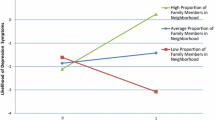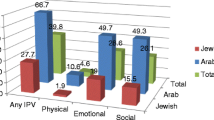Abstract
Intimate partner violence (IPV) remains a public health issue plaguing families and communities in the USA. Despite considerable research devoted to individual-level factors affecting IPV and a smaller body of ecological IPV research, few studies explore the interaction between individual-level protective factors and neighborhood- or community-level factors in predicting the incidents of IPV among women. Moreover, most IPV studies utilize a unidimensional approach for social capital, despite strong empirical and theoretical support for a multi-dimensional conceptualization. In a sample of heterosexual women in the USA (N = 1884), we found that concentrated disadvantage, social and physical disorder, and community violence together significantly predicted increased rates of IPV victimization. Concentrated disadvantage and higher scores on the social capital index independently predicted a lower probability of victimization. Moderating effects were found for social capital: the protective effects of social capital on the probability of IPV were attenuated for those reporting community violence compared with women who did not report it. These findings enhance the field’s understanding of the synergistic relationship between individual- and neighborhood-level factors, providing important implications for community-based IPV interventions.

Similar content being viewed by others
References
World Health Organization. Violence against women. New York, NY: SAGE Publications; 2013.
Breiding M, Chen J, Black M. Intimate partner violence in the United States - 2010. Boston, MA: NISVS; 2014.
Sugg N. Intimate partner violence: prevalence, health consequences, and intervention. Med Clin. 2015;99(3):629–49. https://doi.org/10.1016/j.mcna.2015.01.012.
Campbell JC. Health consequences of intimate partner violence. Lancet. 2002;359(9314):1331–6. https://doi.org/10.1016/S0140-6736(02)08336-8.
Devries KM, Mak JY, Bacchus LJ, Child JC, Falder G, Petzold M, et al. Intimate partner violence and incident depressive symptoms and suicide attempts: a systematic review of longitudinal studies. PLoS Med. 2013;10(5):e1001439. https://doi.org/10.1371/journal.pmed.1001439.
Wright EM, Pinchevsky GM, Benson ML, Radatz DL. Intimate partner violence and subsequent depression: examining the roles of neighborhood supportive mechanisms. Am J Community Psychol. 2015;56(3):342–56. https://doi.org/10.1007/s10464-015-9753-8.
Wathen CN, MacGregor JCD, MacQuarrie BJ. Relationships among intimate partner violence, work, and health. J Interpers Violence. 2016;33(14):2268–90. https://doi.org/10.1177/0886260515624236.
Beyer K, Wallis AB, Hamberger LK. Neighborhood environment and intimate partner violence: a systematic review. Trauma Violence Abuse. 2013;16(1):16–47. https://doi.org/10.1177/1524838013515758.
Voith LA. Understanding the relation between neighborhoods and intimate partner violence: an integrative review. Trauma Violence Abuse. 2017;20(3):385–97. https://doi.org/10.1177/1524838017717744.
Frye V, Blaney S, Cerdá M, Vlahov D, Galea S, Ompad DC. Neighborhood characteristics and sexual intimate partner violence against women among low-income, drug-involved New York City residents: results from the IMPACT studies. Violence Against Women. 2014;20(7):799–824. https://doi.org/10.1177/1077801214543501.
Beyer KMM, Layde PM, Hamberger LK, Laud PW. Does neighborhood environment differentiate intimate partner femicides from other femicides? Violence Against Women. 2014;21(1):49–64. https://doi.org/10.1177/1077801214564075.
Mears D, Carlson M, Holden G, Harris S. Reducing domestic violence revictimization: the effects of individual and contextual factors and type of legal intervention. J Interpers Violence. 2001;16(12):1260–83. https://doi.org/10.1177/088626001016012003.
Dekeseredy WS, Schwartz MD, Alvi S, Tomaszewski EA. Perceived collective efficacy and women’s victimization in. Crime Justice. 2003;3(1):5–27. https://doi.org/10.1177/1466802503003001001.
Cunradi CB. Intimate partner violence among Hispanic men and women: the role of drinking, neighborhood disorder, and acculturation-related factors. Violence Vict. 2009;24(1):83–97. https://doi.org/10.1891/0886-6708.24.1.83.
Naved RT, Persson LÅ. Factors associated with physical spousal abuse of women during pregnancy in Bangladesh. Int Fam Plan Perspect. 2008;34(2):71–8.
Reed E, Silverman JG, Welles SL, Santana MC, Missmer SA, Raj A. Associations between perceptions and involvement in neighborhood violence and intimate partner violence perpetration among urban, African American Men. J Community Health. 2009;34(4):328–35. https://doi.org/10.1007/s10900-009-9161-9.
Uthman OA, Moradi T, Lawoko S. Are individual and community acceptance and witnessing of intimate partner violence related to its occurrence? Multilevel Structural Equation. PLoS One. 2011;6(12):e27738. https://doi.org/10.1371/journal.pone.0027738.
Gracia E, López-Quílez A, Marco M, Lladosa S, Lila M. The spatial epidemiology of intimate partner violence: do neighborhoods matter? Am J Epidemiol. 2015;182(1):58–66. https://doi.org/10.1093/aje/kwv016.
Browning CR, Cagney KA. Neighborhood structural disadvantage, collective efficacy, and self-rated physical health in an urban setting. J Health Soc Behav. 2002;43(4):383–99. https://doi.org/10.2307/3090233.
Coker AL, Davis KE, Arias I, Desai S, Sanderson M, Brandt HM, et al. Physical and mental health effects of intimate partner violence for men and women. Am J Prev Med. 2002;23(4):260–8. https://doi.org/10.1016/S0749-3797(02)00514-7.
Frye V, Paul MM, Todd M-J, Lewis V, Cupid and Jane Coleman M, Salmon C, et al. Informal social control of intimate partner violence against women: results from a concept mapping study of urban neighborhoods. J Community Psychol. 2012;40(7):828–44. https://doi.org/10.1002/jcop.21493.
Raghavan C, Rajah V, Gentile K, Collado L, Kavanagh AM. Community violence, social support networks, ethnic group differences, and male perpetration of intimate partner violence. J Interpers Violence. 2009;24(10):1615–32. https://doi.org/10.1177/0886260509331489.
Raghavan C, Mennerich A, Sexton E, James SE. Community violence and its direct, indirect, and mediating effects on intimate partner violence. Violence Against Women. 2006;12(12):1132–49. https://doi.org/10.1177/1077801206294115.
Van Wyk JA, Benson ML, Fox GL, DeMaris A. Detangling individual-, partner-, and community-level correlates of partner violence. Crime Delinq. 2003;49(3):412–38. https://doi.org/10.1177/0011128703049003004.
Frye V. The informal social control of intimate partner violence against women: exploring personal attitudes and perceived neighborhood social cohesion. J Community Psychol. 2007;35(8):1001–18. https://doi.org/10.1002/jcop.20209.
Sampson RJ, Raudenbush SW, Earls F. Neighborhoods and violent crime: a multilevel study of collective efficacy. Science (80- ). 1997;277(5328):918 LP–924. https://doi.org/10.1126/science.277.5328.918.
Ross CE, Mirowsky J. Neighborhood disorder, subjective alienation, and distress. J Health Soc Behav. 2009;50(1):49–64. https://doi.org/10.1177/002214650905000104.
Wright EM, Benson ML. Clarifying the effects of neighborhood context on violence “behind closed doors.”. Justice Q. 2011;28(5):775–98. https://doi.org/10.1080/07418825.2010.533687.
Browning CR. The span of collective efficacy: extending social disorganization theory to partner violence. J Marriage Fam. 2002;64(4):833–50. https://doi.org/10.1111/j.1741-3737.2002.00833.x.
Anderson E. Code of the street: decency, violence, and the moral life of the inner city. New York, NY: W.W. Norton; 1999.
Tung EL, Johnson TA, O’Neal Y, Steenes AM, Caraballo G, Peek ME. Experiences of community violence among adults with chronic conditions: qualitative findings from Chicago. J Gen Intern Med. 2018;33(11):1913–20. https://doi.org/10.1007/s11606-018-4607-3.
Bourdieu P. The forms of capital. In: Handbook of theory and research for the sociology of education. Westport, CT: Greenwood; 1986. p. 241–58.
Coleman JS. Social capital in the creation of human capital. Am J Sociol. 1988;94:S95–S120. https://doi.org/10.1086/228943.
Kirst M, Lazgare LP, Zhang YJ, O’Campo P. The effects of social capital and neighborhood characteristics on intimate partner violence: a consideration of social resources and risks. Am J Community Psychol. 2015;55(3):314–25. https://doi.org/10.1007/s10464-015-9716-0.
Woolcock M, Narayan D. Social capital: implications for development theory, research, and policy. World Bank Res Obs. 2000;15(2):225–49. https://doi.org/10.1093/wbro/15.2.225.
McLanahan S, Garfinkel I. The fragile families and child well-being study: questions, design, and a few preliminary results.; 2000. https://fragilefamilies.princeton.edu/sites/fragilefamilies/files/wp00-07-ff-mclanahan.pdf. Accessed 14 Dec 2018.
Reichman NE, Teitler JO, Garfinkel I, McLanahan SS. Fragile families: sample and design. Child Youth Serv Rev. 2001;23(4):303–26. https://doi.org/10.1016/S0190-7409(01)00141-4.
Lloyd S. The effects of domestic violence on women’s employment. Law Policy. 1997;19(2):139–67. https://doi.org/10.1111/1467-9930.00025.
Straus M. Chapter 3 Measuring intrafamily conflict and violence: the conflict tactics (CT) scales. In: Physical Violence in American Families. New York, NY: Routledge; 2017.
Voith LA, Brondino MJ. Neighborhood predictors of intimate partner violence: a theory-informed analysis using hierarchical linear modeling. Am J Community Psychol. 2017;60(1–2):187–98. https://doi.org/10.1002/ajcp.12163.
Center for Research on Child Wellbeing, Columbia Population Research Center. The fragile families and child wellbeing study (survey of parents) fifteen-year follow-up in-home observations. https://fragilefamilies.princeton.edu/sites/fragilefamilies/files/ff_hv_q15.pdf. Accessed 8 July 2020.
Bradley RH, Caldwell BM. The HOME inventory and family demographics. Dev Psychol. 1984;20(2):315–20. https://doi.org/10.1037/0012-1649.20.2.315.
Coulton CJ, Korbin JE, Su M. Measuring neighborhood context for young children in an urban area. Am J Community Psychol. 1996;24(1):5–32. https://doi.org/10.1007/BF02511881.
Breiding MJ. Prevalence and characteristics of sexual violence, stalking, and intimate partner violence victimization—National Intimate Partner and Sexual Violence Survey, United States, 2011. Morb Mortal Wkly report Surveill Summ (Washington, DC 2002). 2014;63(8):1.
VanderEnde KE, Yount KM, Dynes MM, Sibley LM. Community-level correlates of intimate partner violence against women globally: a systematic review. Soc Sci Med. 2012;75(7):1143–55. https://doi.org/10.1016/j.socscimed.2012.05.027.
Jain S, Buka SL, Subramanian SV, Molnar BE. Neighborhood predictors of dating violence victimization and perpetration in young adulthood: a multilevel study. Am J Public Health. 2010;100(9):1737–44. https://doi.org/10.2105/AJPH.2009.169730.
Wright EM. The relationship between social support and intimate partner violence in neighborhood context. Crime Delinq. 2012;61(10):1333–59. https://doi.org/10.1177/0011128712466890.
Stueve A, O’Donnell L. Urban young women’s experiences of discrimination and community violence and intimate partner violence. J Urban Health. 2008;85(3):386–401. https://doi.org/10.1007/s11524-008-9265-z.
Kiss L, Schraiber LB, Hossain M, Watts C, Zimmerman C. The link between community-based violence and intimate partner violence: the effect of crime and male aggression on intimate partner violence against women. Prev Sci. 2015;16(6):881–9. https://doi.org/10.1007/s11121-015-0567-6.
Li Q, Kirby RS, Sigler RT, Hwang S-S, LaGory ME, Goldenberg RL. A multilevel analysis of individual, household, and neighborhood correlates of intimate partner violence among low-income pregnant women in Jefferson County, Alabama. Am J Public Health. 2010;100(3):531–9. https://doi.org/10.2105/AJPH.2008.151159.
Farrington DP, Loeber R. Some benefits of dichotomization in psychiatric and criminological research. Crim Behav Ment Health. 2000;10(2):100–22. https://doi.org/10.1002/cbm.349.
Grych J, Hamby S. Advancing the measurement of violence: challenges and opportunities. Psychol Violence. 2014;4(4):363–8. https://doi.org/10.1037/a0037886.
Anguelovski I. From environmental trauma to safe haven: place attachment and place remaking in three marginalized neighborhoods of Barcelona, Boston, and Havana. City Community. 2013;12(3):211–37. https://doi.org/10.1111/cico.12026.
Flood M. Involving men in efforts to end violence against women. Men Masculinities. 2011;14(3):358–77. https://doi.org/10.1177/1097184X10363995.
Boyko JA, Wathen CN, Kothari A. Effectively engaging stakeholders and the public in developing violence prevention messages. BMC Womens Health. 2017;17(1):35. https://doi.org/10.1186/s12905-017-0390-2.
Wilkins N, Myers L, Kuehl T, Bauman A, Hertz M. Connecting the dots: state health department approaches to addressing shared risk and protective factors across multiple forms of violence. J Public Heal Manag Pract. 2018;24 https://journals.lww.com/jphmp/Fulltext/2018/01001/Connecting_the_Dots__State_Health_Department.6.aspx. Accessed 18 Oct 2019.
Goodman LA, Banyard V, Woulfe J, Ash S, Mattern G. Bringing a network-oriented approach to domestic violence services: a focus group exploration of promising practices. Violence Against Women. 2015;22(1):64–89. https://doi.org/10.1177/1077801215599080.
Acknowledgements
This study received no grant funding.
Funding
This resaerch was conducted with no funding support.
Author information
Authors and Affiliations
Corresponding author
Additional information
Publisher’s Note
Springer Nature remains neutral with regard to jurisdictional claims in published maps and institutional affiliations.
Rights and permissions
About this article
Cite this article
Voith, L.A., Azen, R. & Qin, W. Social Capital Effects on the Relation between Neighborhood Characteristics and Intimate Partner Violence Victimization among Women. J Urban Health 98, 91–100 (2021). https://doi.org/10.1007/s11524-020-00475-1
Published:
Issue Date:
DOI: https://doi.org/10.1007/s11524-020-00475-1




